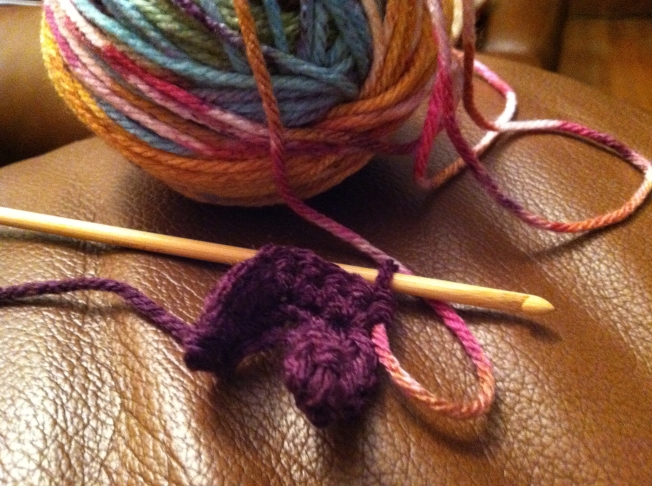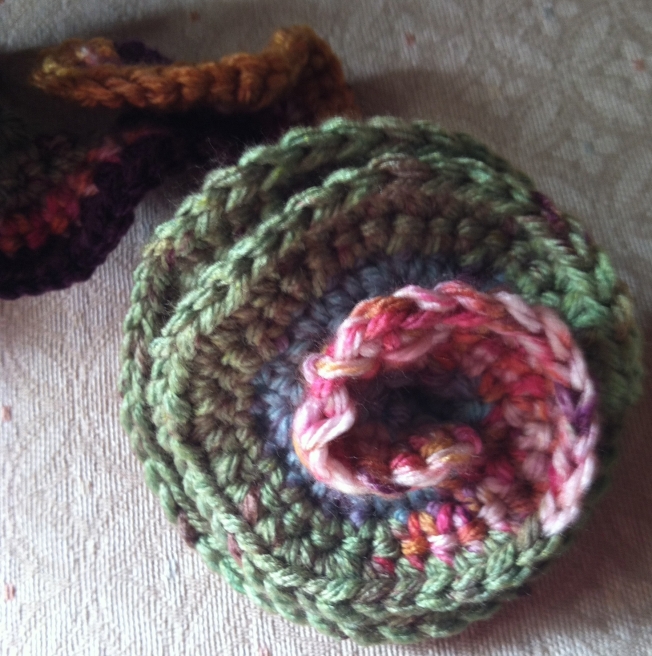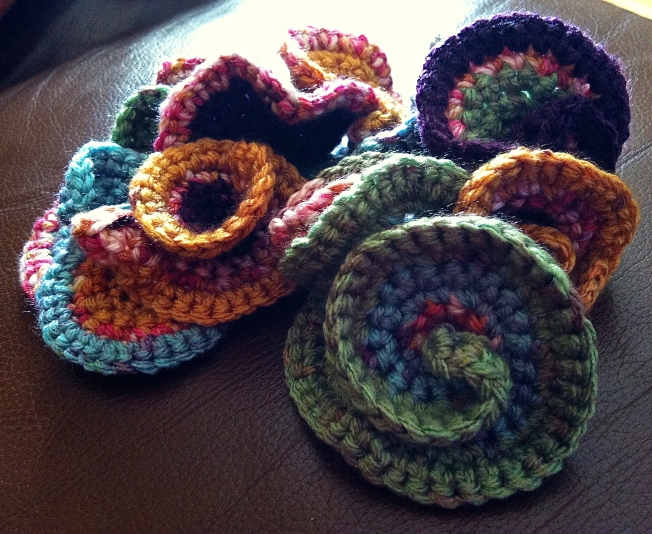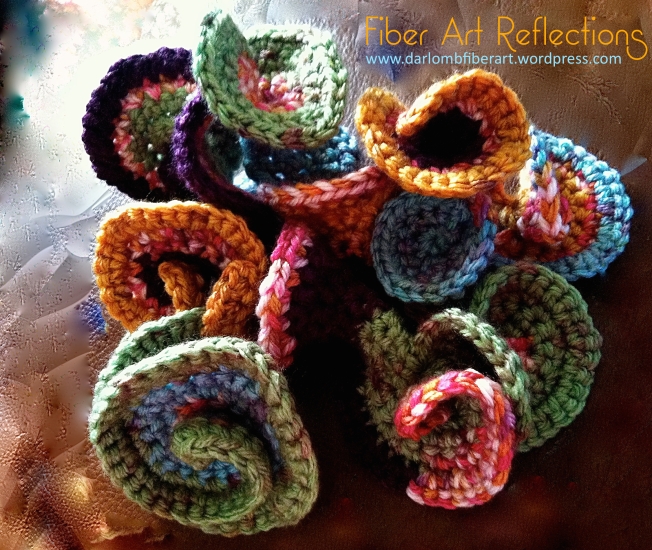Creating a Crochet Sculpture
I love creating freeform crochet sculptures. It gets me into a state of “flow”, helps me relax, and brings about a sense of joy. Today I thought I’d share a tutorial on a project I recently made. I started with a ball of variegated yarn and here is how the piece evolved:

Chain 8 + 1 turning chain. Single Crochet (U.S. crochet terminology) in second chain from hook. *2 SC in next chain. 1 SC in next chain.* Repeat from * to * until the the end of row.

At end of first row, make a turning chain. Turn and continue to increase in every other stitch. 1 SC in first stitch, 2 SC in second stitch, 1 SC in third stitch, etc. to the end of the row.

Chain 9 (8 chains + 1). Make the next spiral node the same as the first. (SC in second chain from hook. Increase in every other stitch, for 4 rows).

Variation – instead of chaining 9 at the end of the last spiral node to begin a new one, start crocheting a 5th row (increasing in every other stitch as with the other rows). But this time STOP after crocheting 9 SCs. Consider this to be “row 1”. Make a turning chain. Continue, the same as with the previous spiral nodes, for 3 more rows.

Toward the end of the project, I just kept going past 4 rows and made an extra big spiral node. This turned out to be 8 rows, increasing in every other stitch.
Here are some pictures of the finished
HYPERBOLIC CROCHET SCULPTURE
.
.
What if…?
Creativity starts with asking the question, “what if?”
What if I start with a different number of chains?
What if I increase in EVERY stitch?
What if I increase in every 4th stitch?
What if I increase the number of rows before starting a new node?
What if I do back loop crochet?
What if I vary the rate of increase differently in each row?
What if I use variegated yarn and only start a new node when the color changes?
What if I use double or triple crochet instead of single crochet?
What if I use a smaller or larger hook?
What if I add some popcorn stitches from time to time?
What if ….?
Please feel free to share your experiments – I’d love to see them! Just put a link to where you have pictures posted (your blog, your Pinterest board, Flickr, etc.) in a comment to this post.
.
The Joy of Finding Flow
I find joy — that sense of being in “flow” when I can immerse myself in a creative endeavor. It’s about emergence and simply enjoying the process. It can be so easy to get caught up in the productivity trap — an overemphasis on the end result. A “flow” experience is about living in the moment. It’s about the spark of inspiration and the joy of creativity. It’s about asking “what if” and experimenting. No rules. No deadline. No need for perfection.
What are you making? Sometimes I hate that question. I know it is well-meaning. But it implies there has to be a utilitarian purpose or it is not of value. What am I making? I’m making an experience. That’s the joy of freeform crochet for me. It’s the difference between being a manufacturer and being an artist.
.
Flow is the Secret to Happiness
Mihaly Cskiszentmihali is a professor and the director of the Quality of Life Research Center at Claremont Graduate University, and the author of several books on the topic of “flow”.
- Csikszentmihalyi, Mihaly (1975). Beyond Boredom and Anxiety: Experiencing Flow in Work and Play, San Francisco: Jossey-Bass.
- Csikszentmihalyi, Mihaly (1978) Intrinsic Rewards and Emergent Motivation in The Hidden Costs of Reward : New Perspectives on the Psychology of Human Motivation eds Lepper, Mark R;Greene, David, Erlbaum: Hillsdale: NY 205-216
- Csikszentmihalyi, Mihaly and Csikszentmihalyi, Isabella Selega, eds. (1988). Optimal Experience: Psychological studies of flow in consciousness, Cambridge: Cambridge University Press.
- Csikszentmihalyi, Mihaly (1990). Flow: The Psychology of Optimal Experience. New York: Harper and Row.
- Csikszentmihalyi, Mihaly (1994). “The Evolving Self”, New York: Harper Perennial
- Csikszentmihalyi, Mihaly (1996). Creativity : Flow and the Psychology of Discovery and Invention. New York: Harper Perennial.
- Csikszentmihalyi, Mihaly (1998). Finding Flow: The Psychology of Engagement With Everyday Life. Basic Books.
.
Here is the blurb from his TED Talks video – Flow Is The Secret to Happiness:
“Mihaly Czikszentmihalyi asks, “What makes a life worth living?” Noting that money cannot make us happy, he looks to those who find pleasure and lasting satisfaction in activities that bring about a state of “flow.”
Mihaly Csikszentmihalyi has contributed pioneering work to our understanding of happiness, creativity, human fulfillment and the notion of “flow” — a state of heightened focus and immersion in activities such as art, play and work.”
View the video below (20 minutes):











Your crochet piece is stunning!! I thought I had put my hooks away for good, but I might have to break them out again.
I recently watched a documentary called “Happy” and saw the professor you mentioned – I had never heard the expression “Flow” before that. The Ted Talks was very interesting – thanks for sharing. I certainly know the value of “Flow”.
Thanks, Joanne! The freeform hyperbolic technique is particularly fun to do when there is some leftover variegated yarn in the stash that is begging to be used for something. It’s a great way to turn the brain off and just “be” in the flow moment. If you have a link to the documentary I’d love to know more about “Happy”.
Fascinating video. This concept of ‘flow’ is new to me. It makes sense and I will be looking into it! I love freeform crochet too. Great blog… I found you via Pinterest. Please keep posting. I am trying to learn more about the history of crochet and different types out there. Your posts are excellent.
Mandy
Welcome, Mandy! I’m glad you like the blog. 🙂 It was like that for me, too, with the idea of “Flow”. It just clicked and made sense right from the start.
Pingback: Learn Freeform Crochet: 15 Free Tutorials to Get You Started | Crafts Crazy
Wow Susan! your sculpture looks amazing – just the link I was looking for to start me off freeforming in three dimensions…is that three-forming?!!
I love variegated yarn and have just the right small ball to have a go.
Love your ‘what ifs’ – I often have a huge bundle of them in my head…
Looking forward to going with the flow
Thanks for you inspiration..off to explore more of your fab blog
Ali
Thanks, Ali! Three-forming – LOVE it! How are your “what ifs” coming along?
Me encanta esta técnica y hacer escultura con tejido es super excitante. Descubrít yo también el blog en Pinterest y voy a seguirlo a través de mi correo
Gracias, Rita!
Oh gorgeous! I’ve always loved the look of freeform crochet, but never known quite how do start it. I have some leftover variegated yarn in beautiful jeweled colors. I’m going to give this a try. (Doing a very excited happy dance!!! 🙂🙃🙂)
Thank you, Teresa! I’m dancing right back with you! It’s a fun way to use up leftover and novelty yarns.
Well I did it – and I blogged about it linking back to this post. If you’d like to have a look the URL is http://myroundtuit.com/2017/10/20/stash-busting/
Pingback: Stash Busting – My "Round Tuit"
Pingback: غرز الكروشيه الحر الأساسية + ماهي التراكيب؟ مع باترونات للتحميل – كاميوشيه
Where can I get a beginners book to learn the free form crochet???
Wow, I haven’t seen the word flow used in this context since I left university many years ago. Thank you for all the links to Mihaly Csikszentmihalyi’s work. Crocheting by what if, instead of a pattern is so energising in this restrained times.